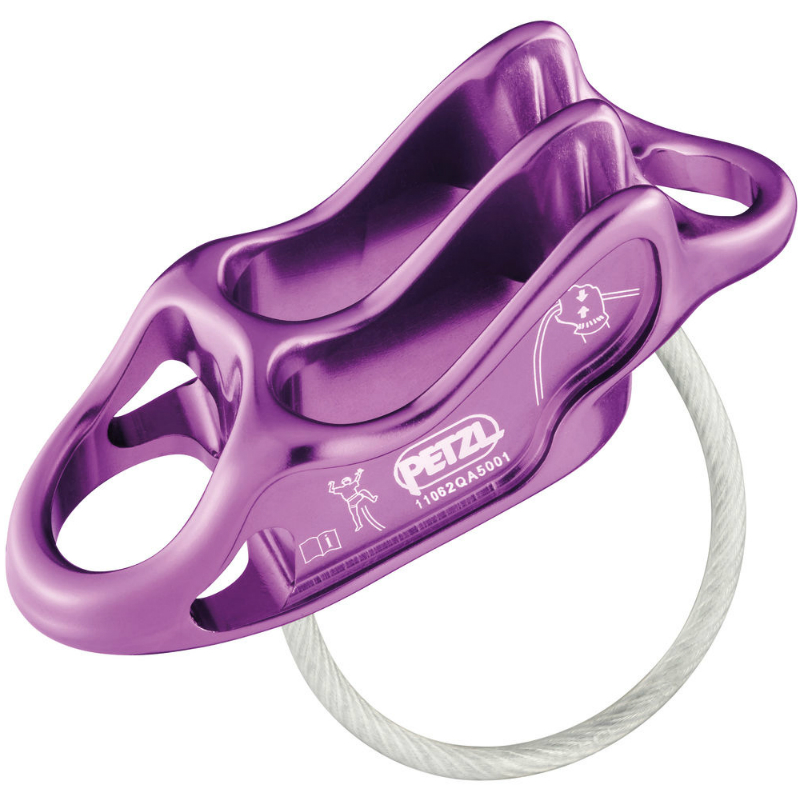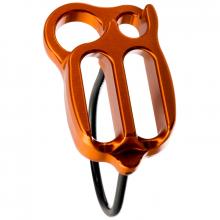Reverso 4
Description
Ultra-light multipurpose belay/rappel device with braking adapted to different rope diameters and suppleness; Reverso mode
This belay/rappel device is lightweight and easy to use. V-shaped friction channels, with asymmetrical side grooves, adapt the rope friction for better control (braking adapted to half, twin and single dynamic ropes). Reverso mode for belaying one or two seconds.
Description
Ultra-light design:
- minimalist construction
- hot-forged aluminum
A single device for all rope types:
- effective braking on half and twin ropes (7.5 mm or greater diameter)
- effective braking on single ropes (8.9 mm or greater diameter)
- can belay the leader, one or two seconds and can be used for rappelling
- independent and simultaneous belaying of two seconds in Reverso mode
- for swapping leads (team of 2), offers a quick transition from Reverso mode to belaying the leader
The V-shaped friction channels:
- give greater braking power on thin ropes
- adapt the braking power on larger diameter ropes
- increase the braking pressure on the ropes in Reverso mode
The asymmetric side grooves:
- increase the braking power for leader or top-rope falls, or while rappelling
- improve rope glide through device when taking up slack
Hole for releasing the device under load: allows a loaded device in Reverso mode to be easily and gradually released with only a carabiner
Rope friendly, facilitates rope maneuvers and rappelling:
- will not twist the ropes regardless of the mode used
- separates the two strands of rope when belaying and rappelling on two ropes
Intuitive use:
- Reverso mode aluminum attachment hole is easy to identify
- keeper cable keeps the device from moving up the rope when belaying and reduces risk of losing the device
- usage diagrams (standard belay and Reverso modes) engraved on device
Use with symmetrical locking carabiners (Am’D or WILLIAM) to maximize efficiency
Retail price
This Product is Hard to Find.
We don’t know where you can buy this item online in the US. We’ll continue to check all the major retailers and will update this page as soon as we find one.
If you know where to find this online in the US, let us know, and we’ll add the link.
Device Type  Device TypeTubeThe most commonly used belay type also called an “ATC” or “tuber.” Other than a distinction between other belay device types, “Tube” is a rarely used term, most climbers just assume you're talking about this style when they refer to your "belay device." 
Figure 8Mostly used in rescue, canyoneering, tactical, work safety, or by old school climbers and rappellers. One reason they went out of popularity with recreational climbers is because they tend to create twists in the rope. 
Brake AssistThese devices assist in stopping the rope when a climber falls or hangs on the rope. 
Often referred to as “auto-blocking” but that’s not the official terminology because no belay device should be assumed to work automatically by itself, even if it feels like it does (or does most the time). PlateWhen simplicity is a must, or you started climbing before Tubers were the norm. Bonus: They tend to be very light weight. 
DescenderFor rappelling, not for belaying a lead climber or top-roping.  |
Tube |
Weight (g)  Weight (g)In grams, the weight, as stated by the manufacturer/brand. |
59 g |
Belay Brake Assist  Belay Brake AssistThis is when the belay device significantly reduces the amount of holding power the belayer must exert to stop a fall and hold a climber. This is also called "assisted-braking" as the device must hold a significant amount of the climber’s weight; this term does not include friction-adding "teeth" found on some tube style belay devices. Confusingly referred to as “auto-blocking” or “auto-locking” these terms wrongly imply the device will always, automatically, stop a fall or hold a climber even if the belayer/rappeller is hands-free. These devices are not meant to be used without a hand on the braking side of the rope; the belayers/rapppeller brake hand should always be on the brake rope. Worth ConsideringMost of the mechanical brake assist devices only hold a single strand of rope and are not capable of double-strand rappelling (the most common method of rappel). |
No |
| Rope Options | 1 or 2 ropes |
Guide Mode  Guide ModeThis is when you belay directly off the anchor instead of your harness. Guide mode is helpful if you climb outdoors a lot because it reduces the holding power required from the belayer. When your partner falls or rests, the weight of the climber is held mostly by the anchor and the belay device. Tubers and PlatesWhen belaying in "guide mode," the tubers and plates turn auto-blocking. During a fall, the climbing rope pinches the slack rope, completely stopping the movement of either rope. A common guide mode setup shown below. 
Mechanical Brake Assist DevicesThere is no difference in the functionality of the device. A brake-hand should always be on the rope to ensure the climber is caught in the case of a fall. A common guide mode setup shown below. 
Where guide mode is used
Learn Morehttp://www.climbing.com/skill/essential-skills-auto-blocking-belay-devices/ |
Up to 2 followers |
Teeth  TeethTeeth are only seen on tube devices. They add friction that helps grip the rope for more belaying control. This is helpful for belaying heavier climbers. Teeth are becoming standard on new tube devices. 
Worth ConsideringTeeth do wear out. You can limit wear by rappelling on the side without teeth (if you don’t need the extra friction). Once they’re worn, you’ll still have a usable belay device, just less friction. |
Yes |
Rope Range (mm)  Rope Range (mm)The range of rope diameters, in millimeters, that the manufacturer/brand specifies can safely be used. This is the best case scenario and does not necessarily take into consideration that certified ropes have a tolerance of +/- .3 mm. Recently, manufacturers have started to add an "optimized" rope range -- this is the range that will result in the nicest handling of the belay device. | 7.5 mm
- 11.0 mm
single: 8.9 - 11.0 half: 8.0 - 11.0 twin: 7.5 - 11.0 |
Certification  CertificationsThe main climbing gear certifications are CE and UIAA--and normally the UIAA creates the rules that the CE body also supports. When possible, we try to list all the certifications the product carries. To sell a climbing product in Europe, the device must be CE certified. There are no official requirements to sell climbing gear in the US. The UIAA certification is a voluntary process. Learn MoreRock and Ice Certifications Guide |
UIAA |
One small feature that led me to choose the Reverso over the ATC Guide is the orientation of the guide mode loop. The loop is oriented horizontally in relation to the device (perpendicular to the tubes), meaning that when it’s clipped into an anchor, the tubes are naturally oriented in the direction of pull. This is not the cause on the Guide, which has a loop oriented vertically.
For years the Petzl Reverso 4 and Black Diamond ATC Guide have been two of the most popular belay devices among American multi-pitch climbers. It's easy to understand why, they're both afforable, smooth, and reliable. At first glance our testers thought they would prefer the Reverso because it's lighter and the shiny anodized finish looks cooler. However, when we actually compared the two side-by-side with the same ropes in a controlled environment (especially in auto-block mode) the ATC Guide came out on top. The difference is small though, so if you've already got a Reverso and like it, don't feel any pressure to switch.
The Reverso 4 is a great tool for top rope belaying and for belaying a leader as well. This winter I caught a couple of falls with it. The skinny ropes were iced up, and it worked admirably. I’m not sure how well a device with larger rope slots like the BD ATC Guide would have worked in this particular situation. Since we all seem to be climbing with skinnier ropes these days, I like the idea of smaller rope slots, and Petzl’s patented Progressive Rope Control.
Overall, I’m impressed with the light weight, and ease of use. Lowering in the plaquette function is pretty easy with a carabiner in the release hole. I’m so sold on it, I can’t imagine ever going back to a different device. Petzl doesn’t redesign things often, but when they do, they do it with intention.
This video shows all the features of Reverso 4 belay device, with comparisons to old Reverso.
A well discussed review of Reverso 4.
This video is really long but informative, it shows all the instruction for using Reverso belay device in details.
Warning: This video is dubbed in English. If you're getting antsy, skip to section 7:40-8:15 for one of the most interesting parts, where they show a hardware specific camera inspection.
How to use the REVERSO 4 (good and bad), various instruction of REVERSO 4 including inspection and techniques.
Description of procedure, how to inspect REVERSO 4.

















